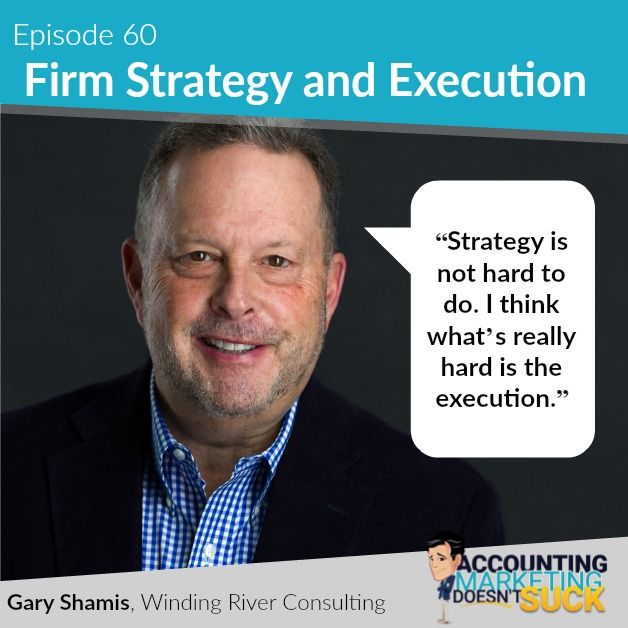Growing From $225K to $100M By Focusing on Execution with Gary Shamis
Gary Shamis talks to Hugh Duffy about why execution is harder than strategy, how developing niches can include both services and industries, and why...
Table of Contents
Part one of two.
Gary Boomer, Allan Koltin, and I have worked together for more than twenty years. We have seen many changes, both good and bad, in the accounting industry in that time. So when Accounting Today brought us together for an exclusive webinar series to discuss the impact of the pandemic on the profession, I knew we would bring the best of our own perspectives and thought-provoking collective assessment to guide firm leaderships’ ability to survive beyond this crisis. We each have our opinions and predictions, but one thing the three of us know for certain: the industry has changed forever.
Our first two (of four) webinars in “The Pandemic and The Profession” addressed 1) the virtual workplace as the new normal and 2) the crisis in industry talent. Below is a summary of my big-picture thoughts on both.
Since the installation of the virtual workplace, when the industry adopted a remote work-from-home (WFH) model, firms have either succeeded or struggled — very few are status quo.
How did firms fail? For one, a firm that had yet to invest technology, particularly the cloud, had a more painful acclimation. In the majority of accounting firms, technology has never really been the big ticket item it needs to be.
These are also the firms that fought against the desire of staff, younger staff in particular, to be able to work remotely. This “old guard” did not believe that the commitment and productivity would be the same. These firms are now paying the price and then some.
Why did firms succeed? Their early adoption of technology changes and upgrades made the biggest difference. They had the cloud, the programs, and the teams to support the staff. These are the firms that allowed staff to take multiple screens home, enabling them to work more seamlessly while out of the office.
Moving forward, firms will be operating somewhere between where we were pre-COVID-19 and where we are today. My guess is that there will not be as much of a balance as a “tilt” between WFH and in-office, with more staff opting to work-from-home more (i.e. three days) and in office “on occasion.”
While it’s not too late, firms that want to compete and thrive need to hop on the technology bandwagon immediately. Firm leadership has to adapt quicker for better long-term viability.
The good news is that we are learning that we can be much more efficient with our time in this new environment. I have said for years that that the biggest problem in the accounting industry is that firms are run by Boomers and populated my Millennials.
I see that things have flipped with COVID-19.
The challenge now is that Boomer leaders are going to need to be the generation that’s going to have to change its mindset in order to get through this. Smart Boomer leaders will listen harder to the needs of the younger generations and start transitioning firms to meet those needs. Those leaders that stay firm, supporting the old regime, the “but-we’ve-always-done-things-this-way” mantra, will fail.
Firms need to be developing a strategy that transfers their culture to this virtual environment.
Externally, they should consider how the client experience has been marginalized — we can’t shake hands, socialize at a sports venue, or meet to discuss strategy over dinner. What about business development (BD) and marketing? Most firms have had very little marketing and/or sales efforts in the last three months because it’s changed so much. Firms need a client service/experience, marketing, and BD strategy, and a concise planto execute with the ability to measure.
Internally, attracting talent, onboarding, and communication, has also changed so drastically in this environment. Performance accountability and evaluations, mentoring and intern programs, and team collaboration have changed quite possibly forever. Firms need to think about how to keepculture consistent throughout the organization and home offices.
Managing a remote workforce is something we are all still grappling with. It needs to be prioritized! This is one sure way to support culture. Firms need to ensure they have good security protocols in place; a process in terms of work being done; daily/frequent huddles in which to communicate (internal text messaging systems should be explored); methods of mutually understood measurement; and programs with which to enhance career development. The client experience and culture transference need to be top of mind or firms risk losing them.
Why would anybody want to go back to normal? Getting our business out of the office has demonstrated to us that the geographic boundaries that once contained our pursuit for exceptional talent and limited our reach for clients we serve in our sweet spots don’t exist anymore.
I think this move to virtual has given firms an amazing opportunity to get talent anywhere in the world and obtain clients anywhere in the world. The firms that really understand this and are working on how to implement a boundary-free strategy are looking at an incredible future.
The biggest takeaway on talent is that until three-months ago, talent was within a radius around the office, but now it can be anywhere in the world. What a huge opportunity for those that can figure it out. These are the firms Millennials will want to work for and grow with.
All this uncertainty — between the pandemic, the protests, and the recession — is going to force firms to take a hard look at their practices and I believe additional layoffs are going to be coming in the near future.
If firms are looking to upgrade talent, they must look at those that come from The Big 4. The bigger firms don’t cut the way smaller firms do. The largest firms in the country didn’t have access to the Payment Protection Program (PPP) program. The PPP was designed to keep people in place, and there are huge benefits to doing so. Given The Big 4 had no incentive to keep people. If you looked at the top 50 firms, about 70% had layoffs of some magnitude. Firms that are not in the Top 50 have had the incentive — and support — to keep employees. Short-term pivots were made to assure firms’ immediate survival. There have been firms that were able to generate significant revenues with the PPP.
Medium term, we have to get back to a solid, strategic plan that may have nothing to do with reallocation of staff, but re-upping and delivery of services.
So, how are firms doing overall? It’s too soon to tell and too difficult to benchmark firms’ progress in this new environment. What I do know is that we are all watching. Closely.

Gary Shamis talks to Hugh Duffy about why execution is harder than strategy, how developing niches can include both services and industries, and why...

1 min read
Gary S. Shamis has been named to Accounting Today’s annual list of “The top 100 most influential people in accounting.” This marks his return to the...

6 min read
The clock is ticking. Where is your firm headed? Part two of two. I shared my thoughts on the first two webinars in Accounting Today’s “The Pandemic...